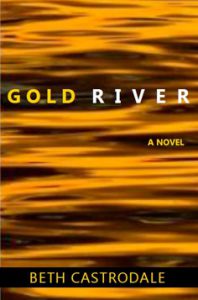A few months ago, I recommended several podcasts that, in my view, do an exceptional job of telling true stories–stories that I found especially strange, surprising, or revelatory, not to mention entertaining. Here, a friend and I will recommend (fictional) tales from another rich source of audio entertainment: the troves of vintage radio programs that are now available online.
Because it would be impossible to do justice to the many commendable vintage programs in a single blog post, we’re focusing on crime/detective dramas, mysteries, and supernatural tales. To my mind, these types of stories are perfect for cold winter nights.
Fortunately, my friend (Jeff Ousborne, who is also a talented writer and musician) is something of an expert in the crime/detective genre, having contributed to Clues: A Journal of Detection, Studies in Popular Culture, and many other publications. Jeff’s expertise was crucial in devising the following roster of programs, presented in (roughly) chronological order.
For most programs, Jeff and I have chimed in with our thoughts and opinions. For my more general reflections on all the shows, see the end of this post.
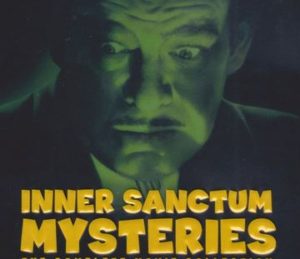 Inner Sanctum Mysteries (1941-1952) This radio show featured tales of mystery, horror, and suspense that began (and ended) with the program’s trademark creepy organ music and creaky-hinged door. Another regular feature was the tongue-in-cheek humor of the host’s introductions. Here’s just one example: “It seems that quite a few people have taken to turning off their refrigerators during this program. … They’ve discovered they can deep freeze all sorts of things by just listening to Inner Sanctum and letting their blood run cold.”
Inner Sanctum Mysteries (1941-1952) This radio show featured tales of mystery, horror, and suspense that began (and ended) with the program’s trademark creepy organ music and creaky-hinged door. Another regular feature was the tongue-in-cheek humor of the host’s introductions. Here’s just one example: “It seems that quite a few people have taken to turning off their refrigerators during this program. … They’ve discovered they can deep freeze all sorts of things by just listening to Inner Sanctum and letting their blood run cold.”
As this example suggests, the humor of the intros hasn’t aged well. But the thrills and chills of certain episodes stand the test of time. Also, several episodes feature performances by such renowned stars as Peter Lorre, Helen Hayes, and Orson Welles.
An episode to try: “Terror by Night,” which begins with a woman on a dark, middle-of-nowhere drive in a failing car and news that a “confirmed killer” is on the loose nearby. You can pretty much predict where things are going–until a case of mistaken identities gives the story an intriguing turn.
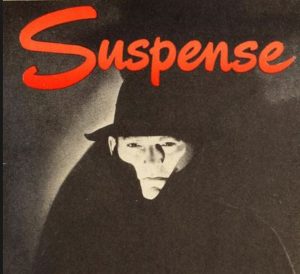 Suspense (1942-1962) Jeff calls this “probably the best radio drama/mystery/thriller show ever,” praising its great production values, music, writing, and actors, including Cary Grant, Lucille Ball, Orson Welles, Richard Widmark, and Robert Montgomery. Jeff notes that there’s “lots of overlap with film noir, mystery writing, and pulp fiction, particularly from about 1945 to 1949, but the quality was really consistent. Lots of fine scripts written by/based on Graham Greene, Raymond Chandler, Cornell Woolrich, John Dickson Carr, and others.”
Suspense (1942-1962) Jeff calls this “probably the best radio drama/mystery/thriller show ever,” praising its great production values, music, writing, and actors, including Cary Grant, Lucille Ball, Orson Welles, Richard Widmark, and Robert Montgomery. Jeff notes that there’s “lots of overlap with film noir, mystery writing, and pulp fiction, particularly from about 1945 to 1949, but the quality was really consistent. Lots of fine scripts written by/based on Graham Greene, Raymond Chandler, Cornell Woolrich, John Dickson Carr, and others.”
An episode to try: “The Hitch-Hiker,” which features Orson Welles as another troubled soul on the road. While driving from Brooklyn to California, he keeps encountering the same forlorn-looking hitch-hiker. Over time, it becomes clear that this stranger wants more than a ride, more than blood or money, and as Welles’ character eventually realizes, there’s no driving away from the fate that’s already been sealed for him.
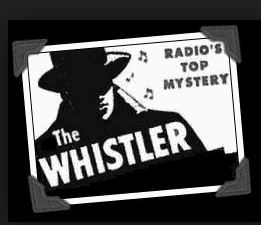 The Whistler (1942-1955) Jeff says, “If Suspense did the glitzier noir with well-known actors, The Whistler provided the well-made B-movie gems. The format is the inverted mystery/crime/
The Whistler (1942-1955) Jeff says, “If Suspense did the glitzier noir with well-known actors, The Whistler provided the well-made B-movie gems. The format is the inverted mystery/crime/
An episode to try: “The Weakling.” When a district attorney’s son breaks the heart of a gangster’s daughter, she jumps from the car he’s driving. After her body turns up, the gangster, Jim Blake, and the D.A.’s chauffeur, confront the son, saying they have evidence to prove that he killed Blake’s daughter. They agree to keep quiet, only if the son gets them what they want (evidence that the D.A. plans to use against Blake, and in the chauffeur’s case, money). When the chauffeur winds up murdered, the investigation of his death reveals larger truths–and twists.
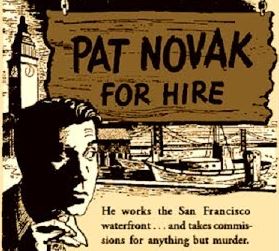 Pat Novak, for Hire (1946-1949) In many episodes of this radio drama, Jack Webb of Dragnet fame played Novak, a hard-boiled San Fransican who takes on risky jobs (reluctantly) for pay. Every episode features him in a wrong-man plot or frame-up. Jeff comments: “This show’s fascinating: it’s like a parody of Raymond Chandler, and if you’re familiar with Jack Webb as Joe Friday [from Dragnet], it’s jarring to hear him as this surly, down-and-out sociopath/anti-hero, whose figurative language is beyond absurd.” Here’s just one example of such language, from the “Roy Malone” episode (described below): “She was as safe a tap dancer on a floor full of dynamite caps.”
Pat Novak, for Hire (1946-1949) In many episodes of this radio drama, Jack Webb of Dragnet fame played Novak, a hard-boiled San Fransican who takes on risky jobs (reluctantly) for pay. Every episode features him in a wrong-man plot or frame-up. Jeff comments: “This show’s fascinating: it’s like a parody of Raymond Chandler, and if you’re familiar with Jack Webb as Joe Friday [from Dragnet], it’s jarring to hear him as this surly, down-and-out sociopath/anti-hero, whose figurative language is beyond absurd.” Here’s just one example of such language, from the “Roy Malone” episode (described below): “She was as safe a tap dancer on a floor full of dynamite caps.”
Jeff pointed out that Raymond Chandler was a fan of Pat Novak, for Hire at first, but then he turned on it. While doing research for a book, Jeff came across a letter from Chandler that retracted his endorsement of the show and recommended Richard Diamond, Private Detective instead. Here’s part of the letter:
The affectation of the writing is just too much for me. The use of similes is unrestrained and was (admittedly, by the original writer of the show) copied from me, and has now been reduced to absurdity. The character can’t even take his hat off without saying the air striking his bald spot was as startling as a yes man saying no, or something just about that silly. Everything is like something else. You get to cringe when you feel one coming on. So ignore the whole business and tune in on the new Dick Powell show, which is swiped from Philip Marlowe which is swiped from Sam Spade . . .”
Chandler’s criticisms aside, Pat Novak makes for entertaining listening.
An episode to try: “Rory Malone.” Malone is a light-weight boxer at the center of a complicated, and potentially lucrative, fight-fixing scheme. When Malone’s manager suspects that something fishy, and potentially dangerous, is going on, he asks for Novak’s help. Then he’s murdered. When Novak finds himself accused of the murder, he races to get to the bottom of things and in the process uncovers some surprising allegiances and betrayals.
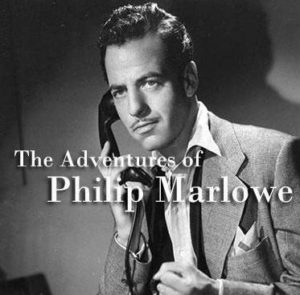 The Adventures of Philip Marlowe (1947-1958) This show immerses listeners in the sleuthing of Philip Marlowe, the private eye at the center of many works by Raymond Chandler, who, according to Jeff, was a fan of the show himself, for a while. Jeff notes: “It’s a well-done whodunit, pretty consistently.”
The Adventures of Philip Marlowe (1947-1958) This show immerses listeners in the sleuthing of Philip Marlowe, the private eye at the center of many works by Raymond Chandler, who, according to Jeff, was a fan of the show himself, for a while. Jeff notes: “It’s a well-done whodunit, pretty consistently.”
An episode to try: “Red Wind,” which is based on the Raymond Chandler story of the same name. At the start of the story, Marlowe finds himself in the middle of a violent scene at a local bar: after a man named Waldo enters, asking if anyone has seen an attractive woman in a blue dress and bolero jacket, he’s shot by another man, who then flees in Waldo’s car. Soon afterward, Marlowe encounters the bolero-jacketed woman, Lola, at his apartment building and learns that she’s looking for Waldo, who’d recently moved into the building. The reason: Waldo had stolen her pearl necklace, a gift from a now-dead lover who Lola (now unhappily married) never got over. More murder, mayhem, and betrayal ensue, and though almost nothing ends well for the characters, the drama ends memorably for listeners, who are treated to some gorgeous closing lines.
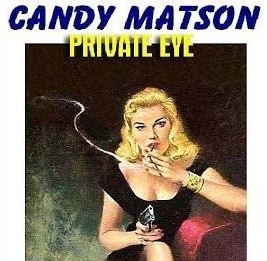 Candy Matson (1949-1952) In this show, San Francisco-based private investigator Candy Matson solves crimes throughout the city, with the help of her friend Rembrandt Watson. The Old Time Radio Researchers Group praises the show: “Candy was bright, tough, and fearless. She used her pistol infrequently, but was unintimidated by bad guys, regardless of circumstances. … OTR experts generally agree that this show was the finest of all the female PIs.”
Candy Matson (1949-1952) In this show, San Francisco-based private investigator Candy Matson solves crimes throughout the city, with the help of her friend Rembrandt Watson. The Old Time Radio Researchers Group praises the show: “Candy was bright, tough, and fearless. She used her pistol infrequently, but was unintimidated by bad guys, regardless of circumstances. … OTR experts generally agree that this show was the finest of all the female PIs.”
An episode to try: “The Egyptian Amulet.” After a woman’s body is discovered in Stow Lake in Golden Gate Park, she’s found to be in possession of an amulet with a message in Arabic. When Candy gets a translation of the message (“The past, the present, the future are mine”), it’s the first clue that leads her to the killer, his motive, and a close call on death-by-entombment.
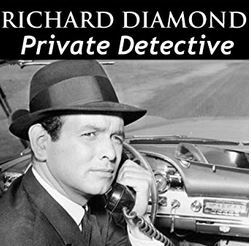 Richard Diamond, Private Detective (1949-1953) Dick Powell starred as the title character, “the wittiest of all the detectives,” according to Jeff. Powell played Raymond Chandler’s Philip Marlowe in the film Murder, My Sweet and starred in other films noir, too. He was also a renowned song-and-dance man, and installments of the radio show ended with Powell-as-Diamond singing an episode-specific tune, often to his lady love.
Richard Diamond, Private Detective (1949-1953) Dick Powell starred as the title character, “the wittiest of all the detectives,” according to Jeff. Powell played Raymond Chandler’s Philip Marlowe in the film Murder, My Sweet and starred in other films noir, too. He was also a renowned song-and-dance man, and installments of the radio show ended with Powell-as-Diamond singing an episode-specific tune, often to his lady love.
An episode to try: “The House of Mystery Case,” in which the show takes a supernatural, and comical, turn. In this episode, a recently widowed woman, Julia Bates, has become troubled by the house she lives in, not only because it contains her late husband’s crypt but because he seems to have returned in ghostly form, threatening to “take her back to the spirit world.” The only reason she doesn’t flee the place is that her husband’s will stipulated that, to collect her inheritance, she would have to stay in the house for three months following his death. On the eve of the three-month mark, a fearful Julia asks Diamond to stay at her place and help ward off her husband’s ill-meaning spirit. But it soon becomes clear that quite another threat needs to be dealt with, and that the only ghoul might be Julia’s butler.
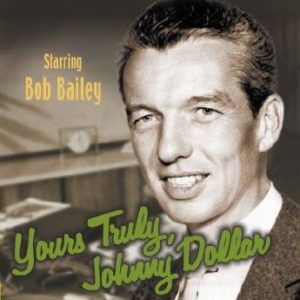 Yours Truly, Johnny Dollar (1949-1962) Billed as “America’s fabulous freelance insurance investigator,” Johnny looks into unusual or suspicious insurance claims, putting him on the trail of a variety of fraudsters and crooks. Scenes are set up with relevant extracts from Johnny’s expense account (e.g., “Expense account item 5: dollar and a half cab fare”), a fun way to structure each story. Jeff calls Yours Truly “probably the best all-around detective show on the radio, particularly in 1955 and 1956, when each episode was aired in five 15-minute episodes a week; this length let the series sprawl and get surprisingly complex in its plots and narratives.”
Yours Truly, Johnny Dollar (1949-1962) Billed as “America’s fabulous freelance insurance investigator,” Johnny looks into unusual or suspicious insurance claims, putting him on the trail of a variety of fraudsters and crooks. Scenes are set up with relevant extracts from Johnny’s expense account (e.g., “Expense account item 5: dollar and a half cab fare”), a fun way to structure each story. Jeff calls Yours Truly “probably the best all-around detective show on the radio, particularly in 1955 and 1956, when each episode was aired in five 15-minute episodes a week; this length let the series sprawl and get surprisingly complex in its plots and narratives.”
An episode to try: “The McCormack Matter.” The McCormack in this episode is Julian McCormack, a wealthy Long Islander who has had $100,000 in jewelry liberated from his home safe. Although a tipster fingers a career criminal in the case, the evidence suggests to Johnny that the theft might be an inside job. He’s right, but not in the ways you might guess.
Now, we’ll jump ahead several years, to a sort of revival for old-style radio dramas. The new shows attempted to recapture the thrills of older dramas, while adding some contemporary twists.
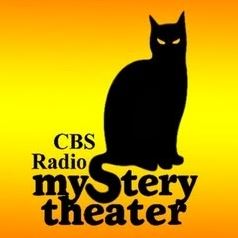 CBS Radio Mystery Theater (1974-1982) This program actually went beyond the mystery genre, also featuring science fiction, horror tales, historical dramas, and more. Though many episodes were originals, CBSRMT also featured adaptations of classic tales by such authors as Edgar Allan Poe, Charles Dickens, and Ambrose Bierce.
CBS Radio Mystery Theater (1974-1982) This program actually went beyond the mystery genre, also featuring science fiction, horror tales, historical dramas, and more. Though many episodes were originals, CBSRMT also featured adaptations of classic tales by such authors as Edgar Allan Poe, Charles Dickens, and Ambrose Bierce.
Created by Himan Brown, who launched Inner Sanctum many years before, CBSRMT attempted to recapture the audiences of old radio shows, though it drew younger listeners with time. Jeff and I have found the episodes to be fun, though often flawed. Jeff notes: “They make me feel nostalgic and cozy. But many of them are awful in a way that’s endearing (clearly old actors playing young people; bad attempts to capture youthful slang; some crappy production values on occasion; stupid plots–e.g., their attempt at a contemporary Dracula). But the show is also like this weird lint-trap of every crackpot ’70s obsession, from the Bermuda Triangle to aliens and everything in between.”
An episode to try: “The Tell-Tale Heart,” an intriguing adaptation of Poe’s classic story, starring Fred Gwynne as a man who takes his family to live on the farm of a cruel uncle, who pushes Gwynne’s character toward madness.
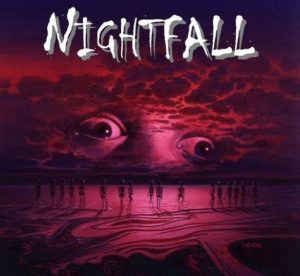 Nightfall (1980-1983) This acclaimed and truly spine-tingling CBC program featured mostly horror tales, though it also aired works of science fiction, mystery, and other genres.
Nightfall (1980-1983) This acclaimed and truly spine-tingling CBC program featured mostly horror tales, though it also aired works of science fiction, mystery, and other genres.
An episode to try: “The Porch Light,” in which a man wakes in the middle of a snowstorm to find his porch light on, and a pajama-clad stranger standing under it. Though the stranger casts no shadow on the snow, he poses a very real danger to the man and his wife, a danger rooted in violent deaths on the property ten years before.
 The Vanishing Point (1984-1991) Also a CBC program, The Vanishing Point has been compared to “The Twilight Zone,” featuring science fiction, as well as tales of mystery, suspense, horror, and anything else with a tinge of the strange. On occasion, it aired literary fiction: John Cheever’s “The Enormous Radio” and Charlotte Perkins Gilman’s “The Yellow Wallpaper,” to give just a couple of examples.
The Vanishing Point (1984-1991) Also a CBC program, The Vanishing Point has been compared to “The Twilight Zone,” featuring science fiction, as well as tales of mystery, suspense, horror, and anything else with a tinge of the strange. On occasion, it aired literary fiction: John Cheever’s “The Enormous Radio” and Charlotte Perkins Gilman’s “The Yellow Wallpaper,” to give just a couple of examples.
An episode to try: “In The Groove.” A father takes his son on a motorcycle trip, hoping to overcome their estrangement. When a fellow guest at a diner describes how his mind has been overtaken by a dead girl’s memory of the incident that killed her, the father is fascinated by the story, but the son is repulsed. This conflict becomes not only another breach in their relationship, but also part of a larger meditation on the ways in which we connect with or isolate ourselves from others, and on what constitutes reality.
Some Final Reflections on My Immersion in Vintage Radio
- At times, I wished that I could have experienced these shows, especially the pre-revival ones, as a listener of their era–that is, with a brain unshaped by modern popular culture. Having read, watched, and listened to so many newer-model crime/detective and horror stories–which have complicated and sometimes upended the character and plot conventions of their predecessors–I couldn’t help but judge the older shows by current standards for satisfying entertainment, and not always favorably. But in the best cases, I found the plotting, character development, and writing of the vintage shows to stand the test of time, and then some.
- I was put off by how often the women in the vintage shows were portrayed as helpless or in need of rescue or protection. Although this surely was a convention for dramas of the time, I feel the need to express my irritation with it, and my gratitude for moments when a woman got in a good kick, swing, or shot at a bad guy. (“Red Wind” from The Adventures of Philip Marlowe offers one good example.)
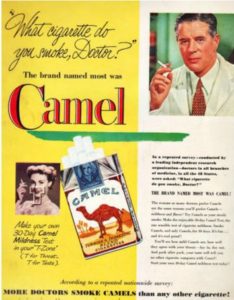
- The advertisements in these old radio shows are worthy of their own blog post. In addition to being fun to listen to, they offer interesting windows on events of the times (as in the ad for war bonds in “The Hitch-Hiker”) and on old-style advertising techniques, such as integrating product pitches into show content (for example, the Inner Sanctum host’s suggestion that Lipton Tea is the perfect antidote to the chills induced by the show). Then there are the product endorsements by authority figures, such as this reassuring pitch from Richard Diamond, Private Detective: “More doctors smoke Camels than any other cigarette.” Although this testimonial is cringe-inducing today, it’s entirely possible that if I’d heard it at the time it was first aired, it might have been just the push I needed toward a lifelong smoking habit.
If you end up listening to any of the programs that Jeff and I have recommended, or if you have your own recommendations to share, I’d love to hear from you in the Comments section.
